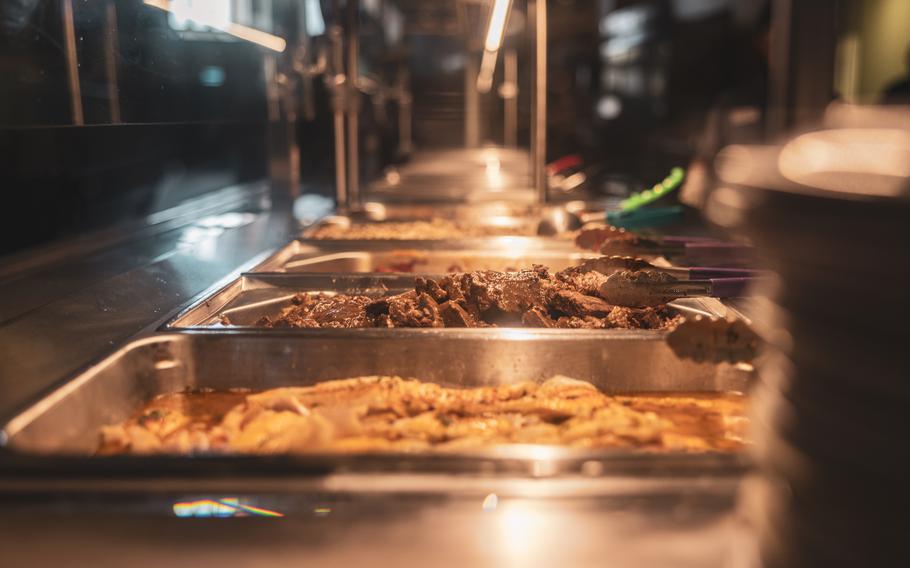
Littleton Mess Hall at Marine Corps Air-Ground Combat Center, Twentynine Palms, Calif., Aug. 9, 2023. Military leaders have an opportunity to improve troops’ health — now and for the rest of their lives — by making healthy eating part of their training. Changing the chow hall could help spark a revolution in military readiness. (Justin J. Marty/U.S. Marine Corps)
Last month, I retired from the Army after serving for more than three decades.
I posted better fitness scores in my final year — as a 53-year-old brigadier general — than I did as a 19-year-old in airborne school. I’m also now healthier and more energetic — with lower cholesterol, to boot — than I was at almost any point in my career.
It’s all because, in my late 40s, my doctor put me on a “keto” diet and told me to stop eating the typical chow-hall menu featuring carbohydrate-rich foods like pasta, pizza, fried rice and potatoes.
My experience isn’t a fluke. The most up-to-date nutritional research suggests that the Army’s standard, carbohydrate-heavy diet is undermining soldiers’ health and combat readiness. Updating our chow-hall menus to feature fewer starches along with more healthy fats and proteins would quite literally improve our national security.
This isn’t the Army’s fault, to be clear. The military, like every federal program, has to follow the U.S. Dietary Guidelines for Americans. Launched in 1980 and updated every five years, these guidelines encourage people to heap their plates with grains while avoiding foods with natural fats like cheese and meat.
Scientists have criticized these guidelines for years, citing incomplete data, inaccurate reviews of the scientific literature, and extensive conflicts of interest. Experts worry, rightly, that eating too many carbohydrates often leads to weight gain and type 2 diabetes. Carbohydrates prompt the body to produce insulin, the hormone that stimulates cells to absorb blood glucose and store it as fat. That’s what makes candy, cookies, bread and pasta notorious fatteners — as well as driving the metabolic processes that lead to heart disease and type 2 diabetes.
Despite this criticism, the most recent guidelines still recommend that people consume up to 65% of their daily calories from carbohydrates.
That means our soldiers are following the same old advice that has coincided with a surge in obesity and other chronic diseases in the U.S. population at large. Fill up on carbohydrates. Refuel every three to five hours, whether they’re hungry or not. Avoid natural fats. A 1,250-calorie army Meal, Ready to Eat (MRE) generally contains 163 grams of carbohydrates, which contribute more than half its total calories — with protein a scant 13%, not nearly enough for a physically active adult.
I’ve seen firsthand how troops wolf down pizza for lunch and then struggle to stay awake during afternoon briefings.
The status quo is making it harder for troops to get, and stay, healthy. Nearly one in five active-duty service members now weighs in as obese.
Those extra pounds threaten combat effectiveness, since obese service members are 33% more likely to sustain injuries. Between 2008 and 2017, military personnel sustained more than 3.6 million musculoskeletal-related injuries — many of which could have been prevented if troops were trimmer. The Department of Defense doles out around $1.5 billion every year to cover obesity-related health issues.
Obesity hurts the military in less direct ways, too — namely, by making recruitment far more difficult. More than one in three Army applicants doesn’t qualify due to being overweight. It’s a key reason the Army has missed its recruitment goals for the past two years.
My own experience is proof that military waistlines and fiscal waste don’t have to keep expanding.
Switching to keto — the most rigorous version of a low-carbohydrate diet — on the advice of an Army doctor concerned about my cholesterol transformed me into the best shape of my life. The pounds fell off as fast as a rucksack at the end of a long march. My heart health metrics also improved, which surprised me since I’d often heard that low-carb, high-fat diets are bad for your heart. But I later realized that’s a myth. The latest research suggests low-carbohydrate diets actually help prevent heart disease.
Updating the guidelines — and thus, military meal plans — to reflect the latest nutritional science could help other troops stave off injuries and chronic disease. Replacing grains and sugars with whole foods such as fish, meat, eggs and nuts would keep troops trim and alert.
Military leaders have an opportunity to improve troops’ health — now and for the rest of their lives — by making healthy eating part of their training. Changing the chow hall could help spark a revolution in military readiness.
Stephen L. Rhoades retired from the Army as a brigadier general on Oct. 31.